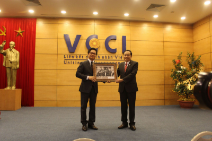Reducing Imported Raw Material Dependence in Leather & Footwear Industry
A major challenge for Vietnam's leather and footwear industry is its heavy reliance on imported raw materials like leather, synthetic materials, fabrics and accessories, despite ongoing efforts to boost local sourcing.

Vietnamese companies should prioritize developing new, sustainable materials that meet international standards and minimize environmental impact
Challenges in sourcing raw materials
According to the Vietnam Leather, Footwear, and Handbag Association (LEFASO), the localization rate for leather and footwear products has improved from 40% a decade ago to 55% today, with sports shoes at 70-80% and canvas shoes nearly 100% locally sourced.
Although there are 129 companies making raw materials, only about 20 can provide high-quality materials. This means manufacturers rely heavily on imports, which makes it hard to get orders and manage the supply chain.
China remains the largest supplier of raw materials to Vietnam's leather and footwear industry, accounting for about 35%, followed by Thailand (11.8%) and Italy (10.3%). Vietnamese companies also import leather from the United States, South Korea, and other markets, but the volume from these sources remains relatively low.
Nguyen Van Khanh, Vice Chairman of the Ho Chi Minh City Leather and Footwear Association, emphasized that although the development of the leather and footwear supporting industry has been talked about for a long time, it hasn't yet met the expectations of the government, businesses, and manufacturers. He suggested that a more extensive and long-term solution is needed.
Long-term solutions
Building a strong domestic supply chain for raw materials is essential for Vietnam. This demands substantial investment in technology, infrastructure, and human resources. Businesses should collaborate to create specialized industrial zones for producing high-quality leather, synthetic materials, and other key inputs. Enhancing domestic production can cut import dependence, stabilize costs, and help meet global quality standards.
Vietnamese companies should focus on developing new, sustainable materials that meet international standards while reducing environmental impact. This could involve research and development (R&D) partnerships with universities, investment in eco-friendly technologies, and the adoption of circular economy principles. By positioning themselves as leaders in sustainable production, Vietnamese manufacturers can access premium markets and command higher prices for their products.
LEFASO highlighted that as Vietnam's leather and footwear sector moves toward producing higher-end products, it will need to invest in new technologies and high-quality materials. To meet these demands, domestic companies must innovate and upgrade their production capabilities, particularly by adopting clean energy and green technologies that align with EU standards.
LEFASO proposed that the government support the creation of specialized industrial zones for making supporting materials for the leather and footwear industry. These zones would focus on eco-friendly production and centralized manufacturing, supporting the industry with the right policies and mechanisms.
To achieve a closed-loop production chain for the sector, strategies should focus on supporting domestic companies, helping them withstand global market fluctuations and avoid exploitation by foreign investors who might use origin rules to gain export benefits. Increasing the localization rate and developing the supporting industry is a challenging issue for many sectors, not just leather and footwear.
Additionally, to boost the development of the supporting industry, it is crucial to build, complete, and effectively implement specialized policies that prioritize this sector.
We should keep offering low interest rates to support industry businesses, focus on improving the domestic value chain, and encourage connections between Vietnamese companies, multinational corporations, and both local and foreign manufacturers.
By concentrating on these efforts, Vietnam can strengthen the development of its leather and footwear supporting industry, aligning with global trends and securing a strong position in the international market.








